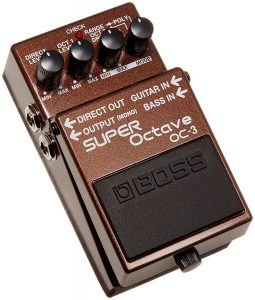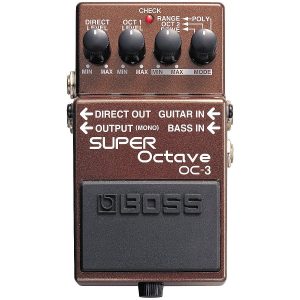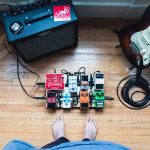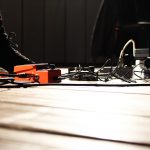The Boss OC-3 Super Octave – A Perfect Compact Polyphonic Octave Pedal?
If you’re familiar with effects pedals, then you’ve no doubt heard of Boss pedals. And, if you’ve seen our octave pedal guide before, then you no doubt know how big of a fan we are of the popular range of effects from the pedal behemoth…and for good reason too.
The OC-3 is a well priced, compact and surprisingly diverse pedal, proudly marketed as the worlds first polyphonic octave pedal with adjustable poly octave effects, drive setting, and an input for bass guitars specifically for adding a modulated octave signal for bass guitar players.
Let’s take a closer look at what has been improved upon since the much loved Oc-2, and why the OC-3 makes the top of our greatest octave pedals guide.
First Impressions

The first impressions of the OC-3 is that appears to be a little ‘busy’, at least in comparison to older, plainer pedals such as the classic DS-1, or even previous versions of the Super Octave range such as the OC-2. However, the pedal is busy for a reason, as you’ll see below with the vast array of features for what really is a fantastic price.
Immediately you’ll see the text on the face of the pedal alluding to both guitar and bass ‘in’, along with a direct out and singular mono output. If this isn’t enough to whet your octave appetite, we don’t know what will. Let’s take a detailed look at the features of the OC-3, what you can do with it, and more importantly what this legendary pedal sounds like.
Check Price
Features
The main standout feature of the OC-3 is the polyphonic octave effect. This simply means that this octave effect can be used when playing a chord, highlighting the total uniqueness of this pedal as before the Oc-3, octave effects could only really be used across singular strings, or for singular notes. With a polyphonic effect, octave notes are split and can be harmonised across multiple strings, meaning that the pedal is able to break down the effect and a modulated signal as a full chord an be emitted as a final result.
As for controls, you will find:
- Direct Level – The direct input of the octave effect that you want to be added to the signal of your guitar or instrument.
- Oct 1 Level – A simple control used to modify the basic octave signal of the pedal. This includes what you can think of as the thickness of the octave output.
- Octave 2 – This is incredible. The Octave 2 effect is the original standard of the previous version of this pedal, the OC-2. This can then be selected and blended with the other controls on the unit.
- Drive – This is another reason to why the Oc-3 is an instant classic. The drive mode kicks the signal into a dirty, fuzz-like effect, essentially transforming what is already an amazing octave pedal into a scorching fuzz unit. This level of drive can then also be controlled and blended with the original octave input.
- Poly – This control allows you to select the note ranges of the octave effect, as alluded to above and the reason why the worlds first compact polyphonic octave effects stomp box is such a big deal.
Additional Features
- Direct Out
- Output (Mono)
- Guitar In
- Bass In
Size and Build Quality
As you may have guessed, this unit is bulletproof like all of the Boss pedals that you’ve come to know and love. If you’re short on pedal board space or need to what the weight when travelling, check out the dimensions and proportions of the OC-3 below:
- Size – 73mm x 129mm x 59mm
- Weight – 440g / 1lbs / 0.4kg
Video Demos
In a live setting, the OC-3 will create a bass emulating effect that will rival any actual bassist on the stage. The drive setting may be a little too fuzzy or heavy unless accompanied with an expression or overdrive pedal to tame the signal a little, however this all depends on the genre you’re playing and personal preference.
The drive effect is not the standard drive effect that many guitarists will be used to or expecting, and it will take a little bit of experimenting before the switch to the drive mode doesn’t send your amp screeching with a full-on, fuzz/distortion effect.
In terms of usability when playing, knobs are a standard size and the pedal itself is a standard Boss size, and can slip into either a guitar case or gig bag very easily.
For Bass Players
Recommended For

This pedal is brilliant for all guitarists, it’s as simple as that. Our only issue is that the drive setting could be a little more tame, however we may see this change and become slightly more of an overdriven effect rather than a full-on distortion setting in later versions of the pedal.
In terms of price, settings, build quality, and even weight, the OC-3 just cannot be faulted. There’s a reason why it’s on the top of our octave pedal list!
Conclusion
A fantastic all-rounder, and logical progression by Boss from the OC-2. The fact that the OC-3 has kept the original settings of the OC-2 for the old-school octave lovers is an added bonus, along with the degree of polyphonic control which will not be found in another pedal of a similar size or price.
Check PriceMore from Pedals
Boss CH-1 Super Chorus Review
By now we've played, reviewed and got engrossed in countless Boss pedals... but what's one more, right? The CH-1 is …
Best Chorus Pedals 2020 – Buyers Guide
As a guitar player, how do you choose the best chorus pedal? The right chorus pedal can add a huge amount …
Jim Dunlop Crybaby Wah Pedal Review
Full Review First Impressions We're perhaps a little biased with the Cry Baby, because it's such an utter classic, so it can …









